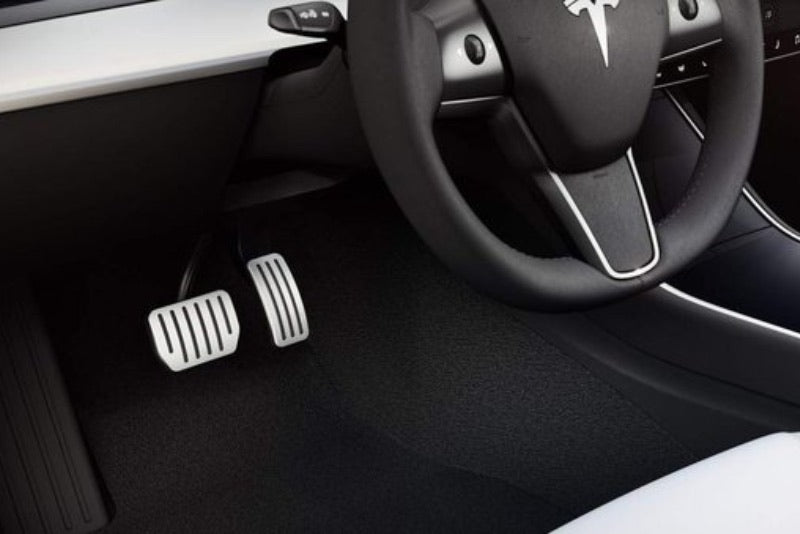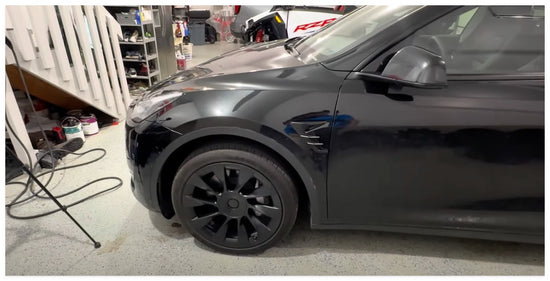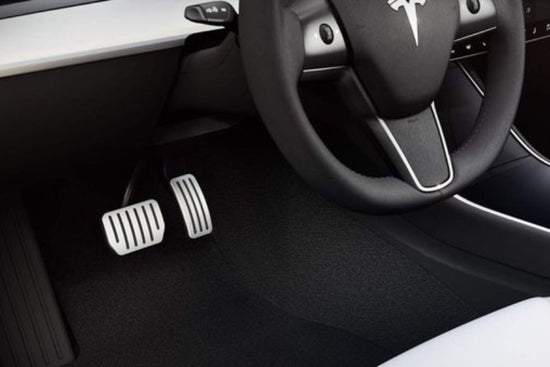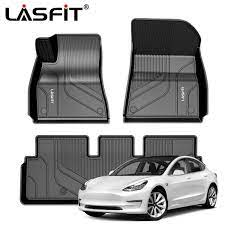Tesla has revolutionized driving with its one-pedal feature, where Tesla models like the Model 3 and Model Y can come to a complete stop just by releasing the accelerator pedal. This method, known as regenerative braking (or regen braking), not only saves energy but significantly reduces wear and tear.
However, it's important to note that while one-pedal driving is the primary method for slowing down, Tesla vehicles still come equipped with a traditional brake pedal for emergency use and additional braking power.
We'll cover more in detail in this article.
The Mechanics Behind Tesla One Pedal Driving
One-pedal driving in Tesla vehicles harnesses the power of regenerative braking. When you release the accelerator pedal, the car's momentum is converted back into electrical energy, which then recharges the battery.
This process not only extends the vehicle's range but also allows for a smoother driving experience, particularly noticeable in stop-and-go city traffic. It's a distinct feature that sets Tesla apart in the realm of electric cars.
What Is Regenerative Braking?

Regenerative braking systems are at the heart of one-pedal driving in electric vehicles. When you decelerate, the kinetic energy usually lost as heat in traditional brakes is instead captured and converted back into electricity. This conversion process slows the vehicle effectively and recharges the battery simultaneously, showcasing a brilliant blend of efficiency and innovation.
Do Teslas Only have One Pedal
Despite the focus on one-pedal driving, Teslas, including the Tesla Model 3, Y, X, and S are equipped with two pedals: the accelerator and the brake pedal.
The concept of one-pedal driving refers to the primary use of the accelerator pedal for both accelerating and decelerating under normal driving conditions.
The brake pedal remains essential for emergency situations and offers drivers an additional layer of control and safety.

Navigating Through One-Pedal Driving
Mastering one-pedal driving in the Tesla enhances the driving experience by making everyday journeys smoother and more efficient. This driving technique becomes second nature with practice, allowing drivers to anticipate stops and manage speed with just the accelerator pedal.
Activation and Customization of One-Pedal Driving in Teslas

As a tesla owner, drivers can easily activate and customize the intensity of one-pedal driving via the vehicle's touchscreen. This flexibility allows for a personalized driving experience, catering to the preferences of both novice and experienced Tesla drivers.
To get started, you must first be Parked, this option will be disabled (greyed out) if you are in drive (see image above)
To Enable One Pedal driving:
- Go to Controls -> Dynamics -> Stopping Mode
- Select one of the following based on preference:
- Creep: similar to gas cars, this will move (creep) the Tesla forward or backward slowly when close to or at a complete stop and the brakes are not applied by you.
- Roll: When near or at a stop, the car will roll similar to neutral settings. Basically, your Tesla does not apply the break for you.
- Hold: Provides regenerative braking at speeds lower than Creep. When the Tesla is at a complete stop, the car will apply the breaks for you. If you release the break during faster speeds, the car will slow you down until you stop completely. This is the option to select when you want "one pedal driving"
I personally use Hold as this just saves me a bunch of effort in a stop and go situation in traffic. Many also prefer Creep as it models traditional cars.
I have yet to find anyone that actually uses Roll.
When you select an option, there is also descriptive text beneath to help you.
See Tesla's owners manual for updates
Balancing Safety and Efficiency with One-Pedal Driving
One-pedal driving in all Tesla model vehicles, is designed with safety and efficiency in mind. The system is supported by modern emergency brake assistance that kicks in during critical situations, ensuring that drivers can enjoy the benefits of one-pedal driving without compromising on safety.
How Do You Turn Off One Pedal Driving in a Tesla?
To disable one pedal driving:
- Go to Controls -> Dynamics -> Stopping Mode
- Select the "Creep" option
Creep makes the car behave similar to a regular car. It will slowly move forward when the brakes are not applied but in Drive and Reverse.

The Advantages of Adopting One-Pedal Driving
One-pedal driving offers several benefits, including reduced brake wear and a more relaxed driving experience. By minimizing the use of the traditional brake pedal, drivers can enjoy smoother transitions and potentially lower maintenance costs over time. This driving style, supported by the one-pedal driving system, marks a significant advancement in the evolution of electric vehicles.

Benefits of One-Pedal Driving for Your Tesla
Adopting one-pedal driving in your Tesla can lead to a more pleasant driving experience. It reduces brake dust and extends the life of braking components, while also enhancing battery efficiency through regenerative braking. Over time, drivers find the technique comfortable, especially when navigating through traffic lights and stop-and-go situations.
The Environmental Impact of Regenerative Braking
Regenerative braking systems play an important role in the environmental advantages of electric cars. By recapturing kinetic energy and slowing the vehicle efficiently, these systems reduce the need for traditional braking, leading to less brake dust and longer-lasting brake components. This not only conserves energy but also contributes to a cleaner environment.
Think of it this way, with regenerative braking, you'll be replacing your brakes at a fraction of the time. One one claims to have reached 100,000 miles before replacing – incredible!
Exploring the Limitations and Disadvantages
While one-pedal driving offers many benefits, it's not without its limitations. According to our research there were claims of infrequent use of the traditional brake pedal leading to rust accumulation on the brake discs.

To counteract this, occasional braking is recommended to maintain the brake system's optimal condition.
When One-Pedal Driving May Not Be Ideal
One-pedal driving, though beneficial in many scenarios, might not be ideal in situations requiring precise speed control or in emergencies where immediate stopping power is necessary. In such cases, the traditional hydraulic brakes provide the necessary stopping force, underscoring the importance of having both options available to the driver.
Understanding the Learning Curve
The shift from traditional driving to mastering one-pedal driving involves a learning curve. Drivers need to adjust to the different feel and response of their vehicle, particularly in how it decelerates. With practice, however, this innovative driving technique becomes intuitive, offering a more engaging and efficient driving experience.
Does the New Model 3 (2024 model) have One Pedal Driving?
Yes, the 2024 model of the Tesla Model 3 continues to feature one-pedal driving and regenerative braking capabilities, emphasizing Tesla's commitment to innovative driving techniques.
This feature, integral to the Tesla driving experience, highlights the brand's focus on efficiency, safety, and the overall enhancement of the electric vehicle experience, especially in stop-and-go city driving.
Conclusion
In wrapping up, Tesla's one pedal driving emerges as a standout feature, enhancing the driving experience by simplifying operations and harnessing regenerative braking.
This tech marvel not only spearheads efficiency, making every journey smoother but also aligns with sustainable driving practices. Whether you're behind the wheel of a Tesla Model 3 or exploring the capabilities of other EV plug-in hybrids, the transition to one pedal driving signifies a step forward in automotive innovation.
Embracing this feature means you're not just driving an EV; you're steering towards a future where engine braking contributes to energy conservation.
So, take the wheel, and let your Tesla redefine the road ahead.




